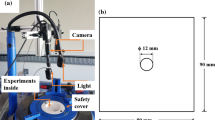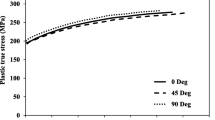Abstract
In this work, strain based fracture forming limit curve (FFLC) of advanced high strength (AHS) steel grade 980 was determined by means of experimental Nakajima stretch-forming test and tensile tests of samples under shear deformation. During the tests, a digital image correlation (DIC) technique was applied to capture the developed strain histories of deformed samples up to failure. The gathered fracture strains from different stress states were used to construct the FFLC. Subsequently, the FFLC in the strain space was transformed to a principal stress space by using plasticity theories. As a result, the fracture forming limit stress curve (FFLSC) of examined steel was obtained. Furthermore, fracture locus (FL) as a relationship between stress triaxialities and critical plastic strains was determined. Hereby, two anisotropic yield functions, namely, the Hill’48 and Yld89 model were taken into account and their effects on the calculated curves were investigated. To verify the applicability of the obtained limit curves, rectangular cup drawing test and forming tests of so-called Diabolo and mini-tunnel samples were performed. Obviously, the FFLSCs and FLs more accurately described the failure occurrences of 980 steel sheets than the FFLCs. In addition, it was found that the drawing depths predicted by the FLs and the Yld89 yield criterion slightly better agreed with the experimental results than those from the FFLSCs and the Hill’48 model, respectively.
























Similar content being viewed by others
References
Panich S, Barlat F, Uthaisangsuk V, Suranantchai S, Jirathearanat S (2013) Experimental and theoretical formability analysis using strain and stress based forming limit diagram for advanced high strength steels. Mater Des 51:756–766
Park N, Huh H, Lim SJ, Lou Y, Kang YS, Seo MH (2016) Facture-based forming limit criteria for anisotropic materials in sheet metal forming. Int J Plast 80:1–35
Uthaisangsuk V, Prahl U, Bleck W (2011) Modelling of damage and failure in multiphase high strength DP and TRIP steels. Eng Fract Mech 78:469–486
Lian J, Sharaf M, Archie F, Muenstermann S (2013) A hybrid approach for modeling of plasticity and failure behaviour of advanced high strength steel sheets. Int J Damage Mech 22:188–218
Muenstermann S, Lian J, Vajragupta N (2014) Modelling the cold formability of dual phase steels on different length scales. Procedia Mater Sci 3:1050–1055
Lian J, Jia X, Muenstermann S, Bleck W (2014) A generalized damage model accounting for instability and ductile fracture for sheet metals. Key Eng Mater 611-612:106–110
Gurson AL (1977) Continuum theory of ductile rupture by void nucleation and growth: part I – yield criteria and flow rules for porous ductile media. J Eng Mater Technol 99:2–15
Tvergaard V, Needleman A (1984) Analysis of the cup-cone fractures in a round tensile bar. Acta Metall 32:157–169
Besson J, Steglich D, Brocks W (2001) Modelling of crack growth in round bars and plane strain specimens. Int J Solids Struct 38:8259–8284
Lemaitre J (1985) A continuous damage mechanics model for ductile fracture. J Eng Mater Technol 107:83–89
Dhar S, Dixit PM, Sethuraman R (2000) A continuum damage mechanics model for ductile fracture. Int J Press Vessel Pip 77:335–344
Keeler SP, Backofen WA (1963) Plastic instability and fracture in sheets stretched over rigid punches. Trans ASM 56:25–48
Uthaisangsuk V, Prahl U, Bleck W (2007) Stress based failure criterion for formability characterization of metastable steels. Comput Mater Sci 39:43–48
Bao Y, Wierzbicki T (2004) A comparative study on various ductile crack formation criteria. J Eng Mater Technol 126(3):314–324
Bao Y, Wierzbicki T (2004) On fracture locus in the equivalent strain and stress triaxiality space. Int J Mech Sci 46(1):81–98
Lou Y, Yoon JW, Huh H (2014) Modelling of shear ductile fracture considering a changeable cut-off value for stress triaxiality. Int J Plast 54:56–80
Lou Y, Huh H (2013) Prediction of ductile fracture for advanced high strength steel with a new criterion: experiments and simulation. J Mater Proc Technol 213:1284–1302
Park N, Huh H, Nam JB, Jung CG (2015) Anisotropy effect on the fracture model of DP980 sheets considering the loading path. Int J Auto Technol 16:73–81
Yin Q, Zillmann B, Suttner S, Gerstein G, Biasutti M, Tekkaya AE, Wagner MFX, Merklein M, Schaper M, Halle T, Brosius A (2014) An experimental and numerical investigation of different shear test configurations for sheet metal characterization. Int J Solids Struct 51:1066–1074
Gorji M, Berisha B, Hora P, Barlat F (2015) Modeling of localization and fracture phenomena in strain and stress space for sheet metal forming. Int J Mater Form 9(5):573–584
Panich S, Suranantchai S, Jirathearanat S, Uthaisangsuk V (2016) A hybrid method for prediction of damage initiation and fracture and its application to forming limit analysis of advanced high strength steel sheet. Eng Fract Mech 166:97–127
Butuc MC, Gracio JJ, Da Rocha AB (2006) An experimental and theoretical analysis on the application of stress-based forming limit criterion. Int J Mech Sci 48:414–429
Barlat F, Lian J (1989) Plastic behavior and stretchability of sheet metals. Part I: a yield function for orthotropic sheets under plane stress conditions. Int J Plast 5:51–66
ISO 12004-2 (2008) Metallic materials - sheet and strip – Determination of forming-limit curves. Part 2: determination of of forming limit curves in the laboratory. Geneva, ISO
Gorji M, Berisha B, Manopulo N, Hora P (2016) Effect of through thickness strain distribution on shear fracture hazard and its mitigation by using multilayer aluminum sheets. J Mater Proc Technol 232:19–33
Li Y, Luo M, Gerlach J, Wierzbicki T (2010) Prediction of shear−induced fracture in sheet. J Mater Proc Technol 210(14):1858–1869
Beese A, Luo M, Li Y, Bai Y, Wierzbicki T (2010) Partially coupled anisotropic fracture model for aluminum sheet. Eng Fract Mech 77(7):1128–1152
Luo M, Wierzbicki T (2010) Numerical failure analysis of a stretch−bending test on dual−phase steel sheets using a phenomenological fracture model. Int J Sol Struct 47:3084–3102
Arrieux R, Bedrin C, Boivin M (1982) Determination of an intrinsic forming limit stress diagram for isotropic metal sheets. In Proceedings of the 12th IDDRG conference, Santa Margherita Ligure, Italy, pp 61-71
Arrieux R (1997) Determination and use of the forming limit stress surface of orthotropic sheet. J Mater Proc Technol 64(1–3):25–32
Stoughton TB (2000) A general forming limit criterion for sheet metal forming. Int J Mech Sci 42:1–27
Uthaisangsuk V, Prahl U, Mueunstermann S, Bleck W (2008) Experimental and numerical failure criterion for formability prediction in sheet metal forming. Comput Mater Sci 43:43–50
Butuc MC, Gracio JJ, Da Rocha AB (2003) A theoretical study on forming limit diagrams prediction. Int J Mater Proc Technol 142:714–724
Basak S, Bandyopadhyay K, Panda S, Partha S (2015) Prediction of formability of bi-axial pre-strained dual phase steels using stress based forming limit diagram. In Proceedings of 5th international and 26th all India manufacturing technology, design and research conference: advances in material forming and joining, pp 167-192
Isik K, Silva MB, Tekkaya AE, Martin PAF (2014) Formability limits by fracture in sheet metal forming. J Mater Proc Technol 214:1557–1565
Panich S, Drotleff K, Liewald M, Uthaisangsuk V (2016) Investigations on fracture curves in strain and stress space for advanced high strength steel forming. J Phys Conf Ser (JPCS) 734:032066
Liewald M, Gall M (2013) Experimental investigation of the influence of shear cutting parameters on the edge crack sensitivity of dual phase steels. In Proceedings of the 32th IDDRG conference, Shanghai, China, pp 219-224
Liewald M, Gall M (2014) Effect of shear cutting induced strain on edge crack sensitivity. AIP Conf Proc 1567:443–447
Charoensuk K, Panich S, Uthaisangsuk V (2017) Damage initiation and fracture loci for advanced high strength steel sheets taking into account anisotropic behaviour. J Mater Proc Technol 248:218–235
Acknowledgements
This research was funded by King Mongkut’s University of Technology North Bangkok (KMUTNB) under the contract nr. KMUTNB−GOV−60−043. Additionally, the authors would like to express their appreciation to Dipl.-Ing. Drotleff, Head of material characterization group, Institute for Metal Forming Technology (IFU), University of Stuttgart for his helpful discussion.
Author information
Authors and Affiliations
Corresponding author
Ethics declarations
Conflict of interest
The authors declare that they have no conflict of interest.
Rights and permissions
About this article
Cite this article
Panich, S., Liewald, M. & Uthaisangsuk, V. Stress and strain based fracture forming limit curves for advanced high strength steel sheet. Int J Mater Form 11, 643–661 (2018). https://doi.org/10.1007/s12289-017-1378-z
Received:
Accepted:
Published:
Issue Date:
DOI: https://doi.org/10.1007/s12289-017-1378-z




